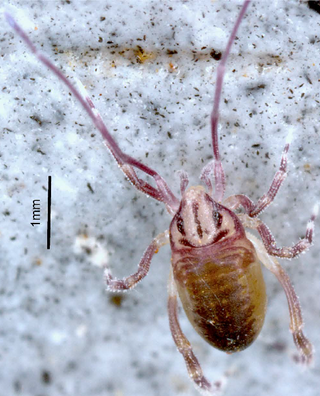
Parasitiformes are a superorder of Arachnids, constituting one of the two major groups of mites, alongside Acariformes. Parasitiformes has, at times, been classified at the rank of order or suborder.

Opilioacaridae is the sole family of mites in the order Opilioacarida, made up of about 13 genera. The mites of this family are rare, large mites, and are widely considered primitive, as they retain six pairs of eyes, and abdominal segmentation. They have historically been considered separate from other mites belonging to Acariformes and Parasitiformes, but are now generally considered a subgroup of Parasitiformes based on molecular phylogenetics.

Mesostigmata is an order of mites belonging to the Parasitiformes. They are by far the largest group of Parasitiformes, with over 8,000 species in 130 families. Mesostigmata includes parasitic as well as free-living and predatory forms. They can be recognized by the single pair of spiracles positioned laterally on the body.

The Laelapidae are a family of mites in the order Mesostigmata. The family is also referred to in the literature as Laelaptidae, which may be the correct spelling.
Antennoseius is a genus of mites in the family Ascidae. As of 2021, it comprised 59 species mostly in subgenera Antennoseius and Vitzthumia, as well as six species not assigned to a subgenus.

Rhinonyssidae is a family of mites in the order Mesostigmata. There are about 16 genera and at least 460 described species in Rhinonyssidae.
Larinyssus is a genus of mites in the family Rhinonyssidae. There are about five described species in Larinyssus.
Passeronyssus is a genus of mites in the family Rhinonyssidae. There are about five described species in Passeronyssus.
Pipronyssus is a genus of mites in the family Rhinonyssidae. This genus has a single species, Pipronyssus manaci.

Ptilonyssus is a genus of mites in the family Rhinonyssidae. There are at least 230 described species in Ptilonyssus.
Rallinyssus is a genus of mites in the family Rhinonyssidae. There are about 12 described species in Rallinyssus.
Rhinoecius is a genus of mites in the family Rhinonyssidae. There are about 12 described species in Rhinoecius.
Rhinonyssus is a genus of mites in the family Rhinonyssidae. There are more than 30 described species in Rhinonyssus.
Ruandanyssus is a genus of mites in the family Rhinonyssidae. There are at least three described species in Ruandanyssus.
Sternostoma is a genus of mites in the family Rhinonyssidae. There are more than 70 described species in Sternostoma.

Tinaminyssus is a genus of mites in the family Rhinonyssidae. There are more than 60 described species in Tinaminyssus.
Trochilonyssus is a genus of mites in the family Rhinonyssidae. This genus has a single species, Trochilonyssus trinitatis.
Zumptnyssus is a genus of mites in the family Rhinonyssidae. This genus has a single species, Zumptnyssus buboensis.

Syringophilidae is a family of mites, commonly known as quill mites. They are obligatory ectoparasites of birds, and inhabit their feather quills where they feed on subcutaneous tissue and fluids. Typically the Syringophilinae inhabit all but the body feathers, while the Picobinae specialize in infecting the body feathers internally. Quill mites have been recorded from hundreds of bird species, belonging to 95 families and 24 orders. Much knowledge of their hosts, diversity and systematics has been obtained since the late 1990's, but as of 2020 these were still considered to be poorly known.
Charletonia is a genus of mites belonging to the family Erythraeidae.







